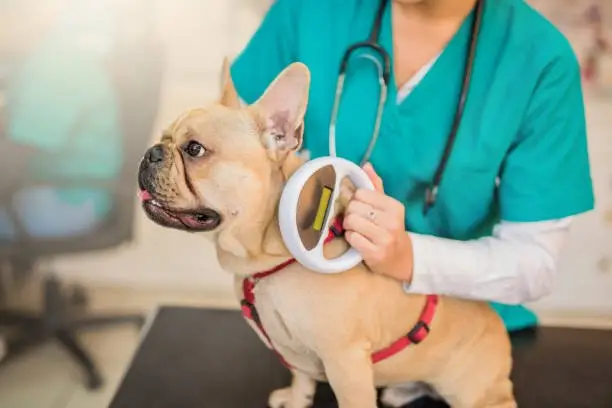Lost pets come home with Peeva.
Debunking Myths: The Real Side Effects of Microchipping Your Dog
As a pet owner, you might have heard various tales and misconceptions about microchipping your furry friend. It’s time to untangle the facts from fiction. Microchipping is a straightforward procedure that offers a permanent solution for identifying your dog. But, like any responsible pet parent, you’re right to wonder about its impact. Let’s dive into the reality of microchipping and why it’s a crucial step for your dog’s safety.
After microchipping your dog, learn how these microchips function to better protect and keep track of your furry friend.
What Exactly Is a Dog Microchip?
Before we debunk myths, let’s clarify what a dog microchip is. It’s a teeny-tiny device, no larger than a grain of rice, that’s implanted under your dog’s skin, usually between the shoulder blades. This microchip carries a unique identification number, which can be read by a scanner. Think of it as a permanent ID tag for your pup.
Myth 1: “Microchipping is Painful for Dogs”
One of the most common myths is that microchipping is a painful process for dogs. Let’s set the record straight. The procedure is similar to your dog getting a routine vaccination. The microchip is implanted using a syringe and most dogs barely react to it. Some might feel a quick pinch, but it’s fleeting. The comfort and safety of your dog are always the top priority during this procedure.
Myth 2: “Microchips are Prone to Personal Data Leakage”
In today’s digital age, concerns about data security are valid. However, dog microchips are designed with your privacy in mind. They don’t store personal data like your address or phone number. Instead, the chip contains a unique ID number. When scanned, this number is used to retrieve your contact information from a secure pet recovery database, where your details are stored safely.

The Real Side Effects: Post-Implantation Considerations
While the process is largely risk-free, it’s crucial to be aware of what to expect post-implantation. In rare cases, there might be slight swelling or redness at the injection site, which typically resolves on its own. It’s also essential to ensure that the microchip remains correctly positioned. A quick vet visit for a chip scan during regular check-ups can confirm this.
Microchipping: A Lifesaver in Disguise
Finally, let’s talk about the real impact of microchipping. It’s a lifesaver. If your dog ever gets lost, a microchip significantly increases the chances of a joyful reunion. Shelters and vets routinely scan found pets for microchips, making it easier to reunite them with their families.
Rare Complications of Dog Microchipping
While the benefits of microchipping are immense, it’s important for pet owners to be well-informed about the potential, albeit rare, complications. Understanding these can help you make an informed decision and ensure the best care for your furry companion.
Understanding the Rarity of Complications
First and foremost, complications from microchipping are not common. Millions of pets are microchipped globally with minimal reports of issues. However, being aware of possible complications can help you stay vigilant and proactive in your pet’s care.
Migration: A Microchip on the Move
One of the complications you might have heard about is microchip migration. This is when the chip moves from its original implantation site. It’s rare, but it can happen. Typically, this doesn’t pose a risk to your dog’s health, but it can make scanning more challenging. Regular vet check-ups can ensure the microchip stays in place and functional.
Infection: A Manageable Risk
Infection at the site of implantation is another possible complication, although it’s extremely rare when the procedure is performed under sterile conditions. If you notice any swelling, redness, or discharge at the implant site, consult your vet. These signs are usually treatable with simple interventions.
Allergic Reactions: Uncommon but Notable
Allergic reactions to the microchip itself are exceedingly rare. The chips are made from biocompatible materials, which means they’re designed to exist in the body without causing a reaction. However, if you notice any unusual symptoms in your dog post-implantation, it’s wise to seek veterinary advice.
Scanner Compatibility: Ensuring Universal Reading
While not a direct complication of the microchipping process, it’s important to note that not all scanners can read all microchips. This is becoming less of an issue as universal scanners become more prevalent. It’s a good idea to check that your local shelters and vet clinics use these universal scanners.
The Big Picture: Safety and Peace of Mind
In conclusion, while there are potential complications, they are rare and generally manageable. The peace of mind and safety that a microchip provides far outweigh these risks. Microchipping is a responsible step that can make a significant difference in the event your dog is lost or separated from you.
Can a Microchip Kill a Dog?
The question “Can a microchip kill a dog?” stems from various myths and misunderstandings surrounding the microchipping process. To address this concern directly: the risk of a microchip causing fatal harm to a dog is extraordinarily low. Let’s explore why and how microchipping is generally a safe procedure for your pet.

Assessing the Safety of Microchips
Microchips are made of biocompatible materials, which means they are designed to be non-reactive and safe inside a dog’s body. The risk of a microchip causing a life-threatening condition is extremely rare. The process of implanting a microchip is quick, similar to a routine vaccination, and is performed with a sterile needle to minimize the risk of infection.
Cases of Adverse Reactions: A Closer Look
In very rare instances, there have been reports of adverse reactions to microchips in dogs. These reactions might include swelling or redness at the implantation site, or, in even rarer cases, an allergic reaction to the chip. However, these instances are extremely uncommon and are generally not life-threatening. They can often be managed effectively with veterinary care.
The Myth of Microchip-Related Cancer
One of the more alarming myths is that microchipping can cause cancer in dogs. This fear stems from a few studies in which some animals (not specifically dogs) developed tumors at the site of a microchip. It’s important to note that these cases are exceedingly rare and that no causal link between microchipping and cancer has been conclusively established. The consensus in the veterinary community is that the benefits of microchipping far outweigh the minimal risk.
Monitoring and Regular Vet Check-Ups
While the microchip itself poses no significant risk, it’s always wise to monitor the implantation site after the procedure. Any changes or discomfort observed should be brought to your vet’s attention. Regular vet visits should include a quick microchip scan to ensure it’s still in place and working correctly. This is a simple step that maintains the effectiveness of the microchip.
The Role of Microchips in Pet Safety
Shifting the focus from the extremely low risks, it’s essential to consider the significant benefits of microchipping. Microchips play a vital role in reuniting lost pets with their owners. They provide a permanent form of identification that can’t be lost or removed like a collar or tag.
Additional Considerations for Pet Owners
While discussing the safety of microchips, it’s also worth exploring related aspects of pet care that contribute to overall health and safety.
Importance of Regular Health Check-Ups
Regular health check-ups are crucial for early detection and prevention of various health issues in dogs. These check-ups can also serve as opportunities to ensure the microchip is functioning correctly.
The Role of a Balanced Diet and Exercise
A balanced diet and regular exercise are key to maintaining your dog’s health. A healthy lifestyle can significantly reduce the risk of various diseases and conditions, further ensuring your dog’s wellbeing.
The Bottom Line
In conclusion, while it’s natural to have concerns about new procedures like microchipping, the evidence overwhelmingly supports its safety and efficacy. The risk of a microchip causing serious harm to a dog is extremely low, especially when weighed against the significant benefits it offers in terms of pet safety and recovery.
Peeva: Where Lost Pets Find Their Way Home
Transform your pet’s microchip into a lifeline. 24/7 phone support and lost pet alerts ensure your pet gets the help they need, when they need it.






